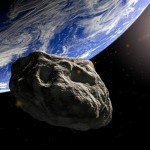 Today, March 23rd, is known as Near Miss Day because it was on this day in 1898 that a large asteroid, named Apollo Asteroid 1989FC…an asteroid that was, in fact, bigger than an aircraft carrier and traveling at 46,000 miles per hour, passed the Earth, and it was a mere 400,000 miles away. The Earth had been at that place in space just six hours earlier. Six hours was all that stood between the Earth and the asteroid. Had it hit the Earth, scientists predicted that it would have left a crater the size of Washington DC, and destroyed everything around it for up to a hundred miles. Of course, that asteroid did not hit earth, and so was forgotten in the minds of most people, with astronomers being the possible exception. Earth does get hit periodically with meteors…some larger than others, and our atmosphere deals with them quite often, burning most of them up, causing what we all know as a shooting star. I find it interesting that we are in the middle of another close encounter right now. This time it is with a comet…or to be more accurate, two comets.
Today, March 23rd, is known as Near Miss Day because it was on this day in 1898 that a large asteroid, named Apollo Asteroid 1989FC…an asteroid that was, in fact, bigger than an aircraft carrier and traveling at 46,000 miles per hour, passed the Earth, and it was a mere 400,000 miles away. The Earth had been at that place in space just six hours earlier. Six hours was all that stood between the Earth and the asteroid. Had it hit the Earth, scientists predicted that it would have left a crater the size of Washington DC, and destroyed everything around it for up to a hundred miles. Of course, that asteroid did not hit earth, and so was forgotten in the minds of most people, with astronomers being the possible exception. Earth does get hit periodically with meteors…some larger than others, and our atmosphere deals with them quite often, burning most of them up, causing what we all know as a shooting star. I find it interesting that we are in the middle of another close encounter right now. This time it is with a comet…or to be more accurate, two comets.
The smaller comet, Comet P/2016 BA14, was difficult to see, but it passed by us at a distance of just 2.2 million miles, making it the third closest flyby of a comet in recorded history. The larger comet is called Comet 252P/Linear. It was first discovered back in 2000, and has been monitored since that time. Comet P/2016 BA14 was only spotted in January this year. At first, astronomers thought it was a potentially dangerous asteroid heading towards us. Comet P/2016 BA14 will make its closest approach at around 11:30am EDT on March 22 (2.30am AEST on March 23). Of course, if you live in the United States, these two occurrences will not be on Near Miss Day, but they will be for those who live in Australia. I don’t know if Australia recognizes Near Miss Day, but if they do, they would find this weeks event interesting too. 
I think that most of the time, we think very little about space…at least most of us do. Space seems so far away, and while we know that there are lots of things floating around out there, we somehow don’t believe they will ever impact Earth. That is even more strange, in that the craters on the moon come from meteor strikes, so why would the Earth somehow be immune. Of course, it wouldn’t be immune at all. The Earth occupies pretty much the same space as the moon. So we could get hit. I know that 400,000 miles seems like a lot, but in the perspective of space, it would be classified as a near miss.


Leave a Reply